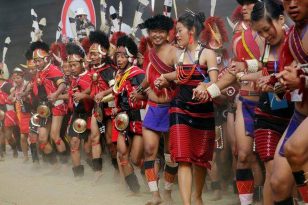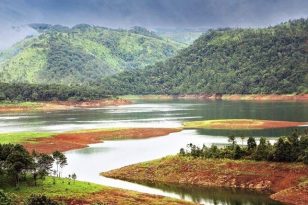| Tour Price | Land Only: £1915 per person on twin sharing basis Prices are all inclusive with no hidden or local payments. |
|
| Flights | We can arrange to book flights for you through our partner travel agent or you can arrange your own flights and we will arrange for your transfer from the place where the tour starts | |
| Best time of visit | September-June | |
| No of days | 8 days | |
| Tour Dossier | Download Dossier | Booking Enquiry |
Overview
In this trip to Bhutan get enchanted by the magnificent views of the Himalayas, valleys, mystical Dzongs and rich Buddhist culture. Walk through the streets of Thimphu, the capital city of Bhutan and visit famous Buddha Dordenma, high up in the mountains and travel through snow capped mountain passes and lush green valleys. Hike up 900 m to the famous Tigers Nest monastery and be spiritually enriched.
Destinations
Paro → Thimphu → Punakha → Gangtey → Paro
Detailed Itinerary
Arrive at Paro International Airport from Delhi, Calcutta, Kathmandu or Bangkok. Paro is situated in a beautiful valley at 2280 metres and is a fitting introduction to this charming kingdom. Your guide will meet you and take you on a short one-hour drive along the Paro and Thimphu river valleys to Thimphu, Bhutan’s capital, at 2320 metres. You can stop on the way to take in the magnificent Tamchhog Lhakhang, the hereditary place of worship for Bhutan’s iron bridge builder. Take a late afternoon walk around town and soak in the atmosphere of this magical capital with its busy shops and bazaars and photogenic citizens in national dress. Overnight in Thimphu.
Accomodation: Galingkha or similar
Today you will visit the weekly market, the revered Memorial Chorten, the National Library and the School of Traditional Arts. You could visit Changangkha temple, perched on the hilltop overlooking the town. Devotees flock throughout the day to circumambulate and turn the prayer wheels. The temple also contains beautiful wall paintings and hundreds of religious scriptures written in gold. In the afternoon you can take in more of the sights and culture of the capital, with the option of a trip to Simtokha Dzong (one of the oldest fortresses in Bhutan, dating from 1629 AD). If you prefer to stay closer to town you could visit the huge statue of Buddha Dordenma, which commands a tremendous view of Thimphu valley. The huge 3-storey throne holds several chapels and the body itself is filled with 125,000 smaller statues of Buddha. You can also visit the Takin Reserve showcasing the unique national animal, the Takin, browse the striking collection of intricate textiles at the National Textile Museum or visit the Folk Heritage Museum. You may also like to visit the newly opened postal museum, detailing the history of Bhutan’s postal system and showcasing Bhutan’s rich assortment of interesting stamps. If you would like to view or buy Bhutanese handicrafts you may like to visit the new market opposite Taj Tashi hotel which has an array of stalls run by local handicraft shops selling purely home made articles with no imports. Tell your guide what takes your interest. Overnight in Thimphu.
Accomodation: Galingkha or similar
In the morning drive approximately 3 hours to the old capital, Punakha, via Dochu La pass at 3050 metres, where we will stop for a hot drink and enjoy spectacular panoramic views of the Eastern Himalayan ranges. You will notice the change of climate and vegetation as we approach low-lying Punakha at 1250 metres. Take a pleasant walk for an hour or so across the terraced fields of Sopsokha village to Chimi Lhakhang (Temple of Fertility) built in the 15th century by the ‘Divine Madman’ (Lama Drukpa Kuenley). Then we will visit the imposing Punakha Dzong, “Palace of Great Happiness”. Built in 1637, it is strategically placed at the confluence of two rivers, the Po Chu and the Mo Chu. Overnight in Punakha.
Accomodation: Zangto Pelri or similar
Drive approximately 3 hours to Gangtey at 2900 metres. Enjoy the views of the immense and remote Phobjikha valley and the black mountain ranges. Visit Gangtey Gompa (one of Bhutan’s oldest monasteries and recently extensively renovated) and explore the valley where the villagers continue to live a traditional Bhutanese rural lifestyle. This is the site where black-necked cranes visit in their hundreds in November each year after spending the summer in Tibet. This afternoon you can do a nature walk and cultural tour of the valley visiting Semchubara and Khewang villages along the way. Overnight in Gangtey.
Accomodation: Dewachen or similar
Today we return to Paro, a drive of approximately 7 hours, via Wangdi. Wangdi (also known as Wangdue Phodrang) was originally considered Bhutan’s secondary capital and it commands an important central position. Sadly Wangdi Dzong was gutted by fire in June 2012, destroying in a few hours not only a magnificent building that had stood proudly for hundreds of years, but also the painstaking work that had been in progress for many months to rebuild recent earthquake damage using traditional construction methods. Renovation work is again underway, but will not be finished until 2021-2022. Meanwhile there is little now to see in Wangdi and after a brief stop continue on your way. In the afternoon there will be time to visit some handicraft shops to purchase some souvenirs of your trip. Then you can meet your host family for an overnight stay in a local farmhouse allowing you to experience traditional Bhutanese village life. Take the opportunity to try the restorative properties of a hot stone bath! If you prefer your creature comforts, you can take tea or dinner with the family and then return to your hotel. Overnight in Paro.
Accomodation: Local farmhouse stay or hotel
This morning you can visit the National Museum housed in the Ta Dzong (watch tower) which was built on top of the hill above Rinpung Dzong to defend Rinpung Dzong and the Paro valley during times of war, in an unusual circular construction resembling a conch shell. The Ta Dzong was badly damaged by an earthquake in September 2011 but has now been renovated and you can see a magnificent collection of Bhutanese artefacts – costumes, religious paintings, arms, textiles and a fascinating collection of Bhutan stamps. Near to the museum you may also be able to see a demonstration of traditional wood turning skills by local artisans who make traditional wooden bowls and cups – and you can try your hand as well if you wish. From the National Museum, take a leisurely 1-hour hike along the forested hillside to Zuri Dzong. The walk passes Gonsaka Lhakhang and then Zuri Dzong and provides wonderful views down over the valley and of Paro Dzong. Zuri Dzong dates from 1352 and is home to the valley’s local protector gods. Continue your walk down to the Uma Resort junction where you turn right towards Paro Dzong and here again you should have a good view of Paro Dzong and town. Your driver will be waiting at the Paro bridge to pick you up. After lunch you can also visit the impressive Paro Rinpung Dzong, one of the finest examples of Bhutanese architecture. Nearby you can also visit the 7th century Kyichu Lhakhang, a temple of historical significance and one of the most sacred shrines in Bhutan. Overnight in Paro.
Accomodation: Gangtey Palace or similar
Take a day walk to the ‘Tiger’s Nest’, the sacred Taktsang monastery which clings to the rock face 900 metres above the valley floor. Guru Rinpoche is said to have flown to the site riding on a tigress. He subsequently meditated here for three months. It is one of Bhutan’s most holy sites and draws pilgrims not only from Bhutan but also from neighbouring Buddhist countries. You can have lunch at the Taktshang cafeteria from where you get a spectacular view of the monastery. If there is any time left for sightseeing after your hike your guide will suggest something for you to see. Overnight in Paro.
Accomodation: Gangtey Palace or similar
Early in the morning your guide will accompany you to the airport to see you off onto your flight and wish you TashiDelek (goodbye and good luck).
Inclusions & Additional Information
- All accommodation as mentioned above
- All meals
- Transportation
- English speaking Birding guide
- All sightseeing and birding as mentioned in itinerary
- Bhutan Royalty and all taxes included
- Bhutan Visa
- Flights
- Insurance
- Items of a personal nature
The accommodation included are all approved by Bhutan Tourism and equivalent to 3 star category hotels in the major cities and towns and basic accommodation facilities in the birding areas.
We organise Bhutanese visas for you. If you are coming in or out via India you will need an Indian visa and you need to apply for this before you leave home. If you are in transit through India and don’t leave the airport in theory you don’t need a visa, but you should check with your international airline that they will allow you to fly without one. Also note that you can’t check your luggage through all the way to Bhutan, so it is easier to manage this if you can go through immigration, collect your luggage and check in again from there. Don’t forget to get a multiple entry visa if necessary. If you are flying with Druk Air or Bhutan Airlines and have a touchdown en route you don’t need a visa for India/Nepal/Bangladesh, as you don’t get off the plane. For Kathmandu if you are stopping over you can get a transit visa on arrival for a short visit for US$5 or a 15-day visa for US$25 – you need to take a passport photo with you. If you come in to Bhutan overland you should be sure to get your exit stamp for India at the immigration office and not at the border.
The Bhutanese unit of currency is called the ngultrum and is pegged to the Indian rupee. Ngultrum are not available outside Bhutan and you cannot easily convert Ngultrum back to dollars. You can spend Indian Rupees in Bhutan and they are at par with Ngultrum. For spending money you should bring dollars if possible, as they are the easiest currency to change. You get better exchange rates for high value ($100) notes and also in some of the luxury hotels.Euros and sterling are also accepted throughout. Travellers’ cheques are not really worthwhile, as the exchange rates are poor. If you do want to buy souvenirs, credit cards can be used now in most places, although you may want to bring cash for market purchases where they won’t be. Visa is more readily accepted than MasterCard but there are places that you can use either. It is possible to use credit cards in a couple of ATM’s in Paro and Thimphu, but only to draw out local currency and not foreign currency. So bring all the US$ cash you think you might need as it is difficult to get hold of it in Bhutan.
We advise you may want to consider ensuring you are protected from typhoid, tetanus, diphtheria, polio, hepatitis and rabies. Japanese encephalitis is also sometimes recommended but check with your doctor or travel clinic once you know the time of year and the nature of your itinerary. In any event you should bring insect repellent, as there is a risk of encountering biting insects even if they don’t carry malaria.
For the best views if coming from Kathmandu it is worth sitting on the left of the plane as you fly into Paro (and on the right when you fly out). It is amazing how close you get to Everest and surrounding peaks! Unfortunately we are unable to influence seating in advance, so make sure you get to the airport in plenty of time to request this at check-in. Generally you should check in 2 hours before the flight. Luggage limits are 30kg per person in economy class and40kg per person in business class (in each case including carry-on bags), although they are generally fairly lax about excess weight and the excess baggage charge is not high.
Except in a few districts in the east of the country where there is a total ban on tobacco, smoking is still allowed in Bhutan but the sale of tobacco is prohibited. So if you need to smoke, bring your own and be prepared to be taxed on your supplies on entry to the country. There is also a recent law prohibiting smoking in offices and some public places.
Overseas mobiles and blackberries generally don’t work in Bhutan, although some report successful connections on the Vodafone network. If you want to you can purchase a SIM card for the B-mobile network and use this in your phone. Internet and wi-fi is also available in most of western Bhutan and in some other towns (including Bumthang), but it is patchy and intermittent with slow speeds.
As a guide, rainfall in Thimphu and Paro is about 25mm a month in January to March, rising to 50mm in April and May, 75mm in June, and then a whopping 355mm in July, 300mm in August, 125mm in September, back down to 75mm in October, 25 mm in November and 0 in December.






